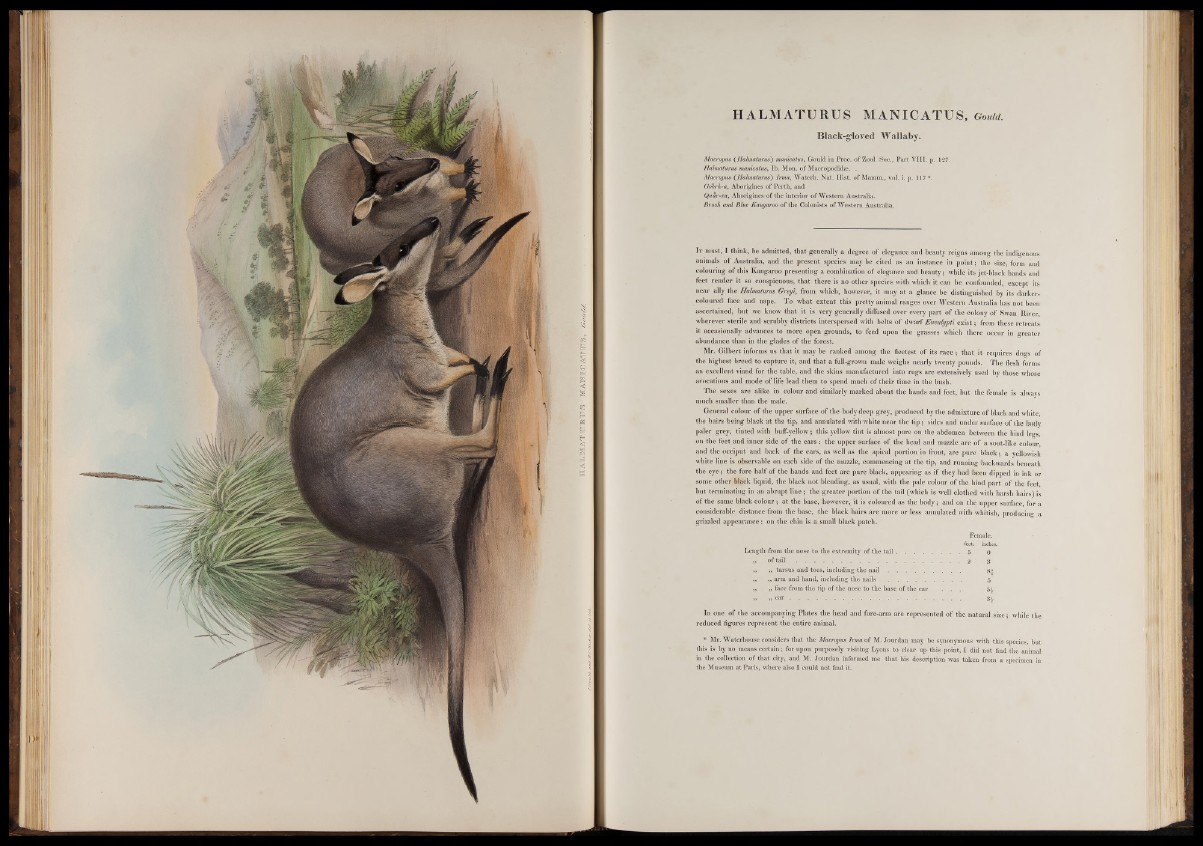
MAlLMATTUmtCrS MAM (C ATP ID'S
HALMATURUS MANICATUS, Gould.
Black-gloved Wallaby.
Macropus (Halmaturus) manicatus, Gould in Proc. of Zool. Soc., Part VIII. p. 127.
Halmaturus manicatus, lb. Mon. of Macropodidse. .
Macropus ( Halmaturus) Irma, Waterb. Nat. Hist, of Mamm., vol. i. p. 117 *.
Go'6rh-a, Aborigines of Perth, and
Quar-ra, Aborigines of the interior of Western Australia.
Brush and Blue Kangaroo of the Colonists of Western Australia.
I t must, I think, be admitted, that generally a degree of elegance and beauty reigns among the indigenous
animals of Australia, and the present species may be cited as an instance in point; the size, form and
colouring of this Kangaroo presenting a combination of elegance and beauty; while its jet-black hands and
feet render it so conspicuous, that there is no other species with which it can be confounded, except its
near ally the Halmaturus Greyi, from which, however, it may at a glance be distinguished by its darker-
coloured face and nape. To what extent this pretty animal ranges over Western Australia has not been
ascertained, but we know that it is very generally diffused over every part of the colony of Swan River,
wherever sterile and scrubby districts interspersed with belts of dwarf Eucalypti exist; from these retreats
it occasionally advances to more open grounds, to feed upon the grasses which there occur in greater
abundance than in the glades of the forest.
Mr. Gilbert informs us that it may be ranked among the fleetest of its ra c e ; that it requires dogs of
the highest breed to capture it, and that a full-grown male weighs nearly twenty pounds. The flesh forms
an excellent viand for the table, and the skins manufactured into rugs are extensively used by those whose
avocations and mode of life lead them to spend much of their time in the bush.
The sexes are alike in colour and similarly marked about the hands and feet, but the female is always
much smaller than the male.
General colour of the upper surface of the body deep grey, produced by the admixture of black and white,
the hairs being black at the tip, and annulated with white near the tip ; sides and under surface of the body
paler grey, tinted with buff-yellow; this yellow tint is almost pure on the abdomen between the hind legs,
on the feet and inner side of the ears : the upper surface of the head and muzzle are of a soot-like colour
and the occiput and back of the ears, as well as the apical portion in front, are pure black; a yellowish
white line is observable on each side of the muzzle, commencing at the tip, and running backwards beneath
the eye; the fore half of the hands and feet are pure black, appearing as if they had been dipped in ink or
some other black liquid, the black not blending, as usual, with the pale colour of the hind part of the feet,
but terminating in an abrupt line; the greater portion of the tail (which is well clothed with harsh hairs) is
of the same black colour; at the base, however* it is coloured as the body; and on the upper surface, for a
considerable distance from the base, the black hairs are more or less annulated with whitish, producing a
grizzled appearance: on the chin is a small black patch.
Female,
feet, inches.
Length from the nose to the extremity of the t a i l ..........................................5 0
,, of t a i l ..................................................................... 2 ' 3
„ „ tarsus and toes, including the n a i l ............................................. gs-
„ ,, arm and hand, including the nails .................................................... 5
,, ~ „ face from the tip of the nose to the base of the ear . . . 54.
„ ear . . . . . . ....................................................................... 31.
In one of the accompanying Plates the head and fore-arm are represented of the natural size; while the
reduced figures represent the entire animal.
* Mr. Waterhouse considers that the Macropus Irma of M. Jourdan may be synonymous with this species, but
this is by no means certain; for upon purposely visiting Lyons to clear up this point, I did not find the animal
in the collection of that city, and M. Jourdan informed me that his description was taken from a specimen in
the Museum at Paris, where also I could not find it.